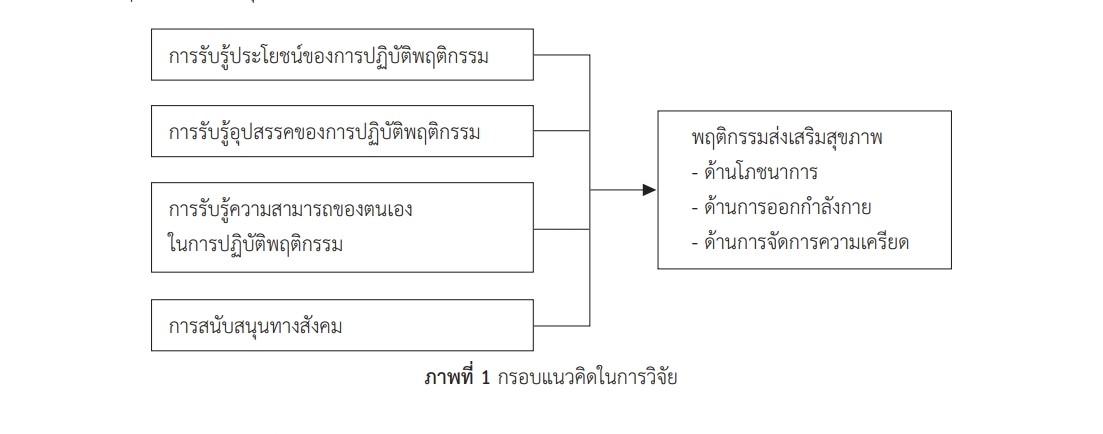ปัจจัยทำนายพฤติกรรมส่งเสริมสุขภาพของหญิงตั้งครรภ์อายุมาก
คำสำคัญ:
พฤติกรรมส่งเสริมสุขภาพ , หญิงตั้งครรภ์อายุมาก, ปัจจัยทำนายบทคัดย่อ
การวิจัยแบบหาความสัมพันธ์เชิงทำนายนี้ มีวัตถุประสงค์เพื่อศึกษาพฤติกรรมส่งเสริมสุขภาพ และปัจจัยทำนายพฤติกรรมส่งเสริมสุขภาพของหญิงตั้งครรภ์อายุมาก กลุ่มตัวอย่าง คือ หญิงตั้งครรภ์ที่มีอายุ 35 ปี ขึ้นไป ที่มาฝากครรภ์ ณ หน่วยฝากครรภ์โรงพยาบาลราชวิถี จำนวน 94 คน คัดเลือกโดยวิธีการสุ่มอย่างง่าย เครื่องมือที่ใช้ในการวิจัย ได้แก่ แบบสอบถามข้อมูลส่วนบุคคล แบบสอบถามการรับรู้ประโยชน์ของการปฏิบัติพฤติกรรม แบบสอบถามการรับรู้อุปสรรคของการปฏิบัติพฤติกรรม แบบสอบถามการรับรู้ความสามารถของตนเองในการปฏิบัติพฤติกรรม แบบสอบถามการสนับสนุนทางสังคม และแบบสอบถามพฤติกรรมส่งเสริมสุขภาพ ซึ่งมีค่าความเชื่อมั่นแอลฟ่าครอนบาคเท่ากับ .79, .75, .81, .94 และ .71, ตามลำดับ วิเคราะห์ข้อมูลโดยใช้สถิติเชิงพรรณนาและการวิเคราะห์ถดถอยพหุคูณแบบขั้นตอน
ผลการวิจัย พบว่า พฤติกรรมส่งเสริมสุขภาพของหญิงตั้งครรภ์อายุมากโดยรวมอยู่ในระดับดี (M = 49.14, SD = 5.02) เมื่อจำแนกเป็นรายด้าน พบว่า ด้านโภชนาการ และด้านการจัดการความเครียด อยู่ในระดับดี (M = 18.77, SD = 2.18 และ M =19.84, SD = 2.17) ส่วนด้านการออกกำลังกาย อยู่ในระดับปานกลาง (M = 10.54, SD = 3.60) ปัจจัยที่สามารถร่วมทำนายพฤติกรรมส่งเสริมสุขภาพของหญิงตั้งครรภ์อายุมากได้แก่ การรับรู้ความสามารถในการปฏิบัติพฤติกรรม การรับรู้ประโยชน์ของการปฏิบัติพฤติกรรม และการสนับสนุนทางสังคม โดยสามารถร่วมทำนายได้ร้อยละ 45 (R2= .45, p < .001) ผลการวิจัยครั้งนี้เสนอแนะว่า การสนับสนุนให้หญิงตั้งครรภ์อายุมากมีพฤติกรรมส่งเสริมสุขภาพที่ดี ควรมีการส่งเสริมการรับรู้ความสามารถของตนเองในการปฏิบัติพฤติกรรม ให้ความรู้เกี่ยวกับประโยชน์ของการปฏิบัติพฤติกรรม รวมทั้งสนับสนุนให้ครอบครัวเข้ามีส่วนร่วม
เอกสารอ้างอิง
Baheiraei, A., Mirghafourvand, M., Mohammadi, E., Nedjat, S., Mohammad-Alizadeh, S. C., Rajabi, F., & Majdzadeh, R. (2011). Health-promoting behaviors and social support of women of reproductive age, and strategies for advancing their health: Protocol for a mixed methods study. BMC Public health, 11(191), 1-5.
Bandura, A. (1997). Self-efficacy: The exercise of control. New York: Freeman.
Boonvas, K., Kampun, S., & Saetan, C. (2016). Factors affecting stress among pregnant adolescents. Journal of Boromarajonani College of Nursing Bangkok, 32(3), 1-10. [In Thai]
Di Mascio, D., Magro-Malosso, E. R., Saccone, G., Marhefka, G. D., & Berghella, V. (2016). Exercise during pregnancy in normal-weight women and risk of preterm birth: A systematic review and meta-analysis of randomized controlled trials. American Journal of Obstetrics & Gynecology, 215(5), 561-71.
Faul, F., Erdfelder, E., Buchner, A., & Lang, A. G. (2009). Statistical power analyses using G*Power 3.1: Tests for correlation and regression analyses. Behavior Research Methods, 41(4), 1149- 1160.
García-Blanco, A., Monferrer, A., Grimaldos, J., Hervás, D., Balanzá-Martínez, V., Diago, V., Vento, M., & Cháfer-Pericás, C. (2017). A preliminary study to assess the impact of maternal age on stress-related variables in healthy nulliparous women. Psychoneuroendocrinology, 78, 97-104.
Hamilton, B. E., Martin, J. A., & Osterman, M. J. K. (2020). Births: Provisional data for 2019. NVSS Vital Stat Rapid Release, 8, 1–10.
Hinman, S. K., Smith, K. B., Quillen, D. M., & Smith, M. S. (2015). Exercise in pregnancy. Sports Health, 7(6), 527–531.
Jariyasakulwong, P., Charoenkitkarn, V., Pinyopasakul, W., Sriprasong, S., & Roubsanthisuk, W. (2018). Factors influencing on health promoting behaviors in young adults with hypertension. Princess of Naradhiwas University Journal, 7(3), 26-36. [In Thai]
Laopaiboon, M., Lumbiganon, P., Intarut, N., Mori, R., Ganchimeg, T., Vogel, J. P., Souza, J. P., & Gülmezoglu, A. M. (2014).
Advanced maternal age and pregnancy outcomes: A multicountry assessment. BJOG, 121(Suppl 1), 49-56.
Lonuch, S., Khampalikit, S., & Nirattharador, M. (2011). Predicting factors of nutritional promoting behaviors among pregnant women over 35 years of age. Journal of Nursing and Education, 4(2), 79-93. [In Thai]
Lowensohn, R. I., Stadler, D. D., & Naze, C. (2016). Current concepts of maternal nutrition. Obstetrical and Gynecological Survey, 71(7), 413-26.
Ministry of Public Health. (2020). Public health statistics A.D. 2019. Retrieved from https://bps.moph.go.th/new_bps/sites/default/files/2563_0.pdf
Okafor, U. B., & Goon, D. T. (2022). Uncovering barriers to prenatal physical activity and exercise among South African pregnant women: A cross-sectional, mixed-method analysis. Public Health, 10, 1-10.
Pancharean, S. (2014). Effects of using health promoting program with family support on health promoting behaviors of primigravida adolescents. Journal of Nursing and Education, 7(3), 113-123. [In Thai]
Pender, N. J., Murdaugh, C. L., & Parsons, M. A. (2015). Health promotion in nursing practice (7th ed.). Boston: Pearson Education.
Phillips, S. M., Wójcicki,T. R., & Mcauley, E. (2013). Physical activity and quality of life in older adults: An 18-month panel analysis. Quality of Life Research, 22(7), 1647–54.
Phumesawat, S., Suvithayasiri, K., & Chaisup, V. (2013). Perceived benefits and health promoting behaviors in pregnant women at antenatal clinic of Rajavithi hospital. Journal of Boromarajonani College of Nursing Bangkok, 29(2), 80-94. [In Thai]
Pinheiro, R. L., Areia,A. L., Pinto, A. M., & Donato, H. (2019). Advanced maternal age: Adverse outcomes of pregnancy: A meta-analysis. Acta Medica Portuguesa, 32(3), 219-226.
Polit, D. F., & Beck, C. T. (2012). Nursing research: Generating and assessing evidence for nursing practice (9th ed.). New York: J. B. Lippincott.
Puttaraksa, S., Supavititpatana, B., & Kantaruksa, K. (2016). Attitudes, subjective norm, perceived behavioral control and intention to exercise among pregnant women. Nursing Journal, 43(3), 24-34. [In Thai]
Robinson, D. J., Coons, M., Haensel, H., Vallis, M., & Yale J. F. (2018). Diabetes and mental health. Canadian Journal of Diabetes, 42, S130–S141.
Sangin, S., & Phonkusol, C. (2021). Perception of pregnancy risk and related obstetric factors among women of advanced maternal age. Pacific Rim International Journal of Nursing Research, 25(3), 494–504.
Sun, X., Shi, Y., Zeng, Q., Wang, Y., Du, W., Wei, N., Xie, R., & Chang, C. (2013). Determinants of health literacy and health behavior regarding infectious respiratory diseases: A pathway model. Retrieved from https://www.ncbi.nlm.nih.gov/pmc/articles/PMC3621712/
Thaewpia, S., Clark, M. J., Howland, L. C., & James, K. S. (2012). Factors predicting health promoting behaviors among older pregnant Thais. Pacific Rim International Journal of Nursing Research, 16(2). 113-123.
Thaewpia, S., Howland, L. C., Clark, M. J., & James, K. S. (2013). Relationships among health promoting behaviors and maternal and infant birth outcomes in older pregnant Thais. Pacific Rim International Journal of Nursing Research, 17(1), 28-38.
Zhang, S., Ding, Z., Liu, H., Chen, Z., Wu, J., Zhang, Y., & Yu, Y. (2013). Association between mental stress and gestational hypertension/preeclampsia: A meta-analysis. Obstetrical and Gynecological Survey, 68(12), 825-834.

ดาวน์โหลด
เผยแพร่แล้ว
รูปแบบการอ้างอิง
ฉบับ
ประเภทบทความ
สัญญาอนุญาต

อนุญาตภายใต้เงื่อนไข Creative Commons Attribution-NonCommercial-NoDerivatives 4.0 International License.




